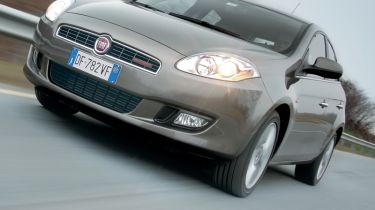Fiat Bravo
Fiat is back on a roll now that its new model has rediscovered desirability

Fiat’s brand new Bravo struggles with a lack of identity. It’s hard to see the car’s unique selling points – things which are perfectly obvious when you look at competing models such as the Volkswagen Golf and Honda Civic. The Italian contender is by no means a bad vehicle: it has good driving dynamics, a fine engine line-up and excellent technology, plus the promise of aggressive pricing. However, it isn’t about to upset the order.
Finally, Fiat is back on a roll. Its models have rediscovered desirability, sales are on the up and a new business plan has seen the Italian maker discharge itself from the intensive care ward. But the best news of all is that the firm has achieved all this by doing what it has always done well: building brilliant small cars.
The current Panda and Punto are both class leaders, boasting enough panache and design flair to win plenty of hearts. But can the larger Bravo do the same?
This car is the work of Fiat’s Style Centre, and it goes on sale in showrooms here in May as a five-door only. The rakish nose and rising waistline, plus small rear windows and screen, certainly provide the Bravo with a distinctive look, although to our eyes it’s not as attractive as the Punto.
Inside, the design team has tried very hard to give the model a fashionable feel, and it has largely succeeded. Yet you cannot help but feel that someone has forgotten about the necessary practicalities.
The cabin isn’t especially spacious, and the back seats don’t fold flush unless you order the optional cargo box floor. There’s not enough underthigh support from the front chairs, either. Disappointingly, the quality is not all it appears upon closer inspection, with uneven panel fit lines and only average plastics in places.
Under the bonnet there is an advanced new 1.4-litre T-JET turbo petrol engine, as well as developments of the existing 1.9 Multijet turbodiesel motors. A 90bhp 1.4-litre naturally aspirated petrol unit will also be offered in the entry-level car.
We sampled the 150bhp 1.9 turbo-diesel teamed with a six-speed manual transmission, and the common-rail engine performed strongly and smoothly. Peak torque of 305Nm arrives at 2,000rpm, allowing for good flexibility in day-to-day driving conditions. Using the latest injection technology, it does away with a lot of the dreaded diesel rattle, and promises a competitive 50.4mpg and CO2 emissions of 149g/km – that means taxation of 19 per cent.
With MacPherson struts at the front and torsion beam rear suspension, the newcomer delivers a supple ride, ample refinement and enjoyable, precise handling. The only thing that lets down the overall experience is the Dualdrive power-steering system; it feels artificial and lifeless through corners. However, the excellent City function – whereby a button on the dash increases power assistance – makes light work of tight, seemingly impossible parking spaces.
The manufacturer promises to “amaze” customers with the Bravo’s pricing and spec levels, and there will be three trims to choose from: Active, Dynamic and Sport. Doubtless the value-for-money factor will help many buyers see past the model’s minor but annoying shortcomings.
Still, it was rather telling that, at the end of our drive, all eyes were not focused on the family hatch. Instead, it was the camouflaged new Fiat 500s undergoing final development testing at the maker’s Balocco track in Italy which were the centre of attention. And there’s the point – the Bravo simply doesn’t sparkle in the way we had expected.
Fiat has always done small best; just look at the current Panda and Punto. Their bigger Bravo brother only serves to prove the point.







